This is not a 'motivational' article or a 'theoretical tutorial', but the rolling position strategy I tested with 10 accounts over the past 3 months, achieving a maximum monthly yield of 2100%.
However, the liquidation rate exceeds 80%.
If you only want to mindlessly follow others, you can close the page now;
But if you are willing to strictly execute the strategy, you might become one of the 20% survivors.
Core logic: The 'compound interest bomb' of rolling positions
The essence of rolling positions is not 'always increasing positions', but 'adding positions on profits and stopping losses on losses', using the compound effect to let profits run.
But 90% of people die in these three pitfalls:
1. Profit but dare not increase position (missed explosive market)
2. Stubbornly holding losses (leading to liquidation)
3. Incorrectly selecting targets (poor liquidity, manipulation)
The core of my strategy: '3x leverage + dynamic profit-taking + hedge protection', which prevents profits from being given back while capturing trending markets.
Target selection: BTC/ETH exchange rate hedge (stable volatility, not easily manipulated)
Opening strategy:
When BTC pulls back to a key support level (like 60,000), open a 3x long position.
After the first profit of 20% (200U), roll 50% of the profit into the next order.
Stop loss: Close the position immediately if it drops below the previous low (control losses within 10%)
Key details:
Only operate from 1-3 AM Beijing time (best liquidity, less manipulation by market makers)
Use limit orders + take profit and stop loss to avoid slippage.
Stage 2: From 3000U to 8000U (10-12 days)
Target upgrade: High-volatility altcoins (like SOL, ORDI)
Rolling position techniques:
Wait for the breakout of the key resistance level, then chase up with 3x leverage.
After a profit of 30%, partially take profits, and set a trailing stop for the remaining position.
If you incur losses on two consecutive trades, stop trading for the day.
Risk control:
Never touch low liquidity altcoins (easy to get harvested)
After each trade, withdraw 10% of the profits to a cold wallet (to prevent overexposure)
Stage 3: From 8000U to 20000U (last sprint)
Ultimate strategy: Contract + spot combo
70% of funds used for BTC/ETH trend trades (5x leverage, capturing large swings)
30% of funds to be allocated for low market cap, high potential coins (like specific exchange IEO coins, details can be discussed privately)
Set automatic profit-taking (lock in some profits every 10% increase)
Last line of defense:
When total funds reach 15,000U**, withdraw the principal and only use profits for trading.
If encountering extreme market conditions, immediately switch to stablecoin arbitrage (annualized 20%+, for life preservation)
Why do 90% of people fail?
1. Loss of control over emotions (profit swelling, losses stubbornly held)
2. Leverage abuse (blindly opening 10x, 20x)
3. Ignore time windows (missed best trading periods)
My solution:
Use quantitative trading robots to execute automatically (to avoid manual operation errors)
Set strict stop-loss discipline (stop trading if daily losses exceed 10%)
Regularly withdraw profits (to prevent 'paper wealth')
This method is also one I have personally tested: from February to March 2025, in one month, starting with 5000, I made it to 100,000! Achieving a profit of 2108.17%!
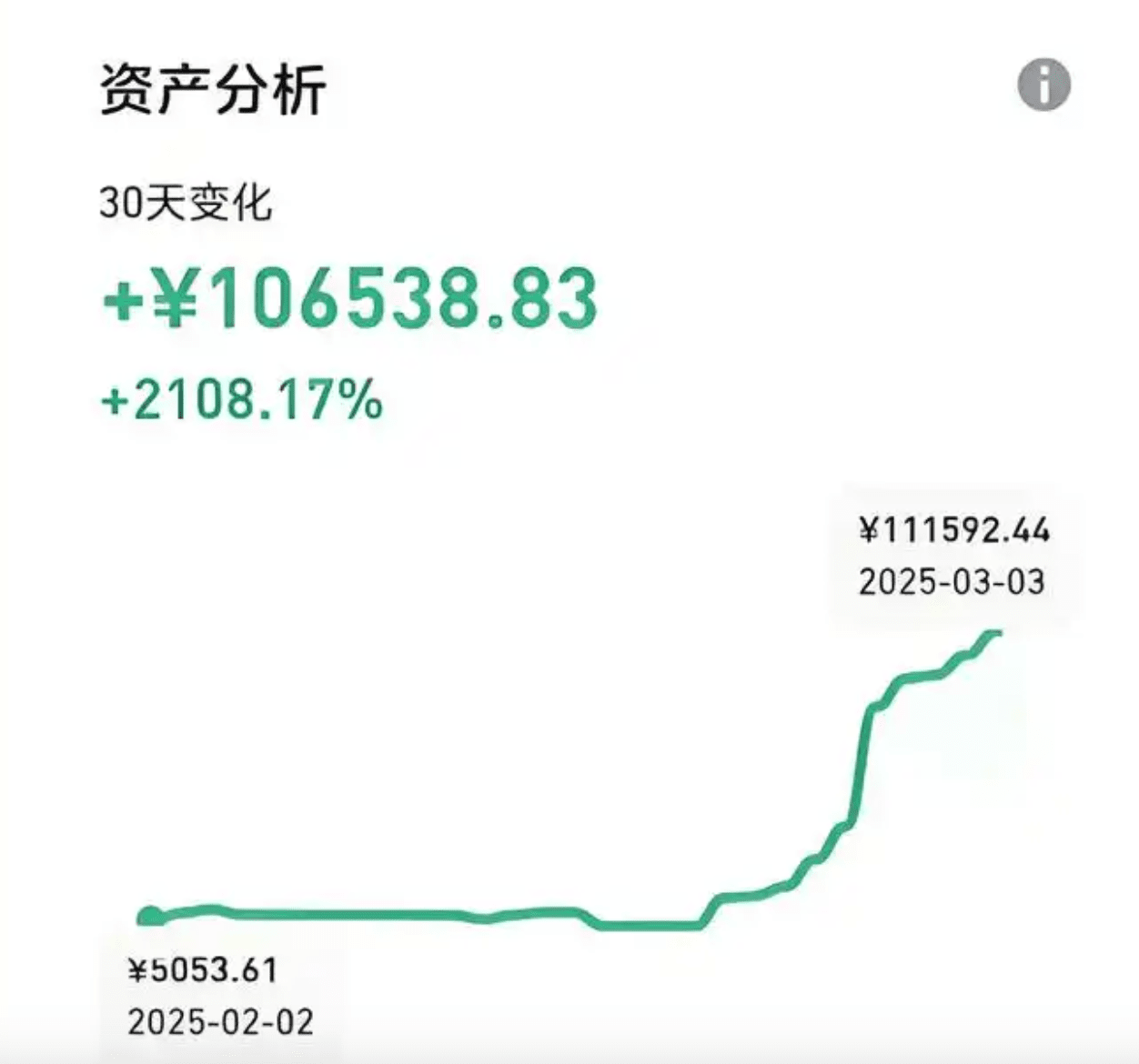
The leverage used in crypto contracts depends on the following conditions:
1. Your risk preference
2. The currency of the opened contracts
3. The size of the contract's capital
4. Are you operating on simple interest or compound interest?
5. Judging the size of the market.
Next, two methods of position management will be introduced!
1. Left-side position management
1) Do not fire all your bullets at once; buy in batches!!!
2) You can divide the funds into several portions; when unsure about the bottom, buying in batches is the most suitable method to average the cost price!!!
(3) The bottom for averaging down should be handled flexibly based on market conditions. Don't average down too frequently; it negatively affects the cost averaging. Starting with 20%, 30%, or 50% is suitable for aggressive investors keen on bottom fishing!!!
(4) Start with a relatively small initial investment. If the coin price does not rise but continues to fall, gradually increase your position, and the proportion of increases becomes larger, thereby averaging the cost. This method has a relatively low initial risk, and the higher the funnel, the more considerable the profit!!
2. Right-side position management
(1) Buy 1: When the 5-day moving average crosses above the 10-day moving average, add 30% to the position!!
(2) Buy 2: When the price effectively breaks through the lifeline, continue to add 30% to the position during the pullback to the lifeline, ensuring that the total position reaches 60% in the early stage of the upward trend!
(3) Buy 3: Break through the neckline or other important resistance levels, and then stabilize after a pullback, indicating that the reversal upward pattern has been established. Increase the position by 20%. The total position should reach 80%, holding the coins and waiting for a rise!!
(4) Buy 4: When the price is above the lifeline and the 5-day moving average crosses the 10-day moving average again, it is a typical signal to accelerate upward. At this time, the remaining 20% of the position should also be bought in time to maximize profits!!!
Foolproof trading method, simple and practical, even if you are a new retail investor, you can easily operate with over 80% accuracy. This method can be applied to buying and selling in the crypto market!
1. The selected coins must be in an uptrend; of course, those in consolidation are also acceptable, but those in a downtrend or with down-opening moving averages cannot be chosen.
2. Divide the funds into three equal parts; when the price breaks through the 5-day moving average, lightly buy 30%, and when the price breaks through the 15-day moving average, buy another 30%. Similarly, buy the last 30% when breaking through the 30-day moving average. This requirement must be strictly executed.
3. If the price does not break above the 15-day moving average after breaking above the 5-day moving average, but instead pulls back, as long as it does not break below the 5-day line, keep the original position; if it breaks below, sell.
4. Similarly, if the price breaks above the 15-day moving average but does not continue to break higher, and pulls back without breaking the 15-day moving average, continue to hold; if it breaks, first sell 30%, and if it does not break below the 5-day moving average, continue holding 30% of the position.
5. When the price continues to break above the 30-day moving average and then pulls back, sell all at once as before.
6. Exiting is the opposite; when the coin price is at a high level, sell 30% when it drops below the 5-day line, and do not continue to sell when it doesn't drop further, holding the remaining 60% position. If the 5-day, 15-day, and 30-day lines all drop, sell everything. Don't harbor false hopes.
A trading system is a weapon that allows you to achieve stable profits.
It can help you mark key levels, discover entry signals, and find trading opportunities that can make you money.
So, going back to what was said, as long as there is a stable trading system, just act on the opportunities within the system. If you incur losses, just take revenge, do what you should do, and leave the rest to the market. After all, profits will always cover losses in the end.
However, 99% of people’s biggest problem is that they do not have their own trading system, so they fear losing money when trading because they can't recover lost money. Even if they make money by luck, they will eventually lose it all through skill.
There is a foolproof method for trading that allows you to maintain 'everlasting profits', aiming for 30 million! This method has achieved an 80% win rate! The '10 Major Chart Patterns' that must be known in crypto trading can accurately predict market trends. Once you master it, the crypto market will be your 'ATM'.
Chart patterns are one of the most effective trading tools for traders.
They purely reflect price behavior, naturally formed by the buying and selling pressures from both bulls and bears. Chart patterns have a proven reliable record, commonly used by traders to identify trend continuation or reversal signals, open positions, and predict price targets.
Chart patterns refer to specific price patterns on charts that can predict future price movements.
Since technical analysis is based on the fundamental assumption that 'history repeats itself', these classic patterns often reveal high probability rules of corresponding price movements after repeatedly verifying specific price charts.
Therefore, chart patterns can be divided into:
(1) Continuation patterns - indicating that the existing trend will continue;
(2) Reversal patterns - indicating that the trend is about to reverse.
This article will showcase ten classic chart patterns that every trader should know. The first part will detail reversal patterns and their application methods.
Reversal patterns (Part 1)
Head and shoulders pattern
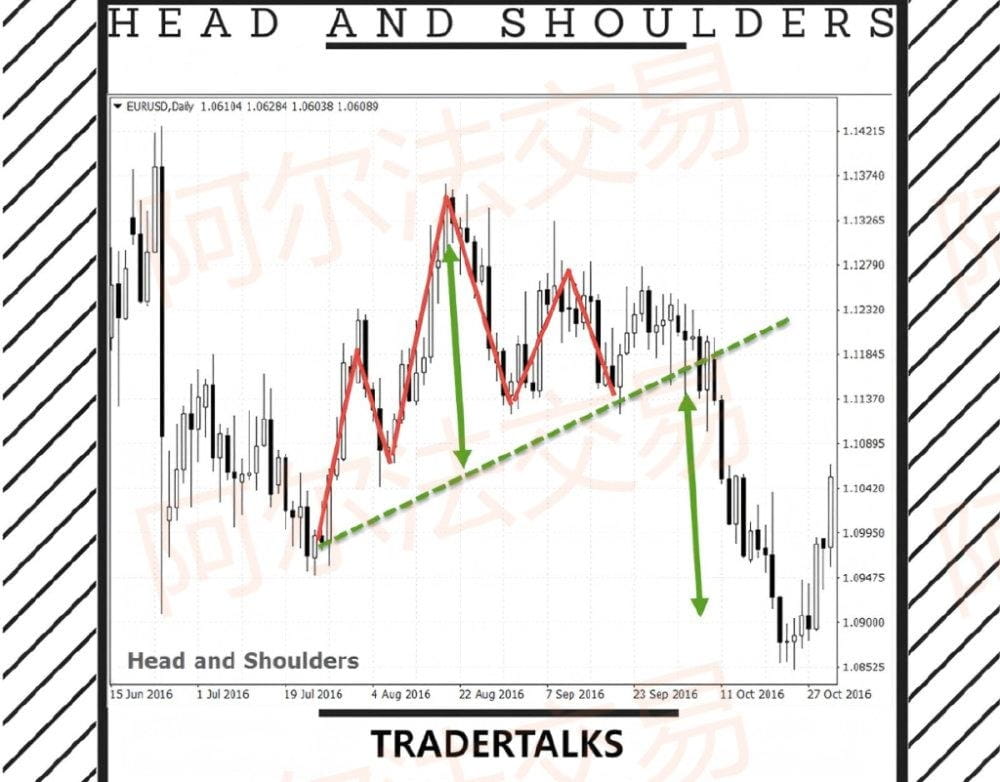
Head and shoulders pattern (Head and Shoulders) is a classic chart pattern that signals a reversal of the current trend.
This pattern consists of three peaks (high points), with the middle peak (head) being the highest (marked by the red line in the chart).
When a lower peak appears after the middle peak, it indicates that the bulls no longer have the strength to push the price higher. Its shape resembles a head outline with left and right shoulders, hence the name.
The line connecting the lowest points of the two shoulders is called the neckline.
Important Note: When the price breaks down through the neckline, it is a sell signal, with the target price being the vertical distance from the head peak to the neckline (marked by the green arrow).
If the head and shoulders pattern appears in a downtrend, it is called an inverted head and shoulders pattern (consisting of three troughs).
Double tops and double bottoms
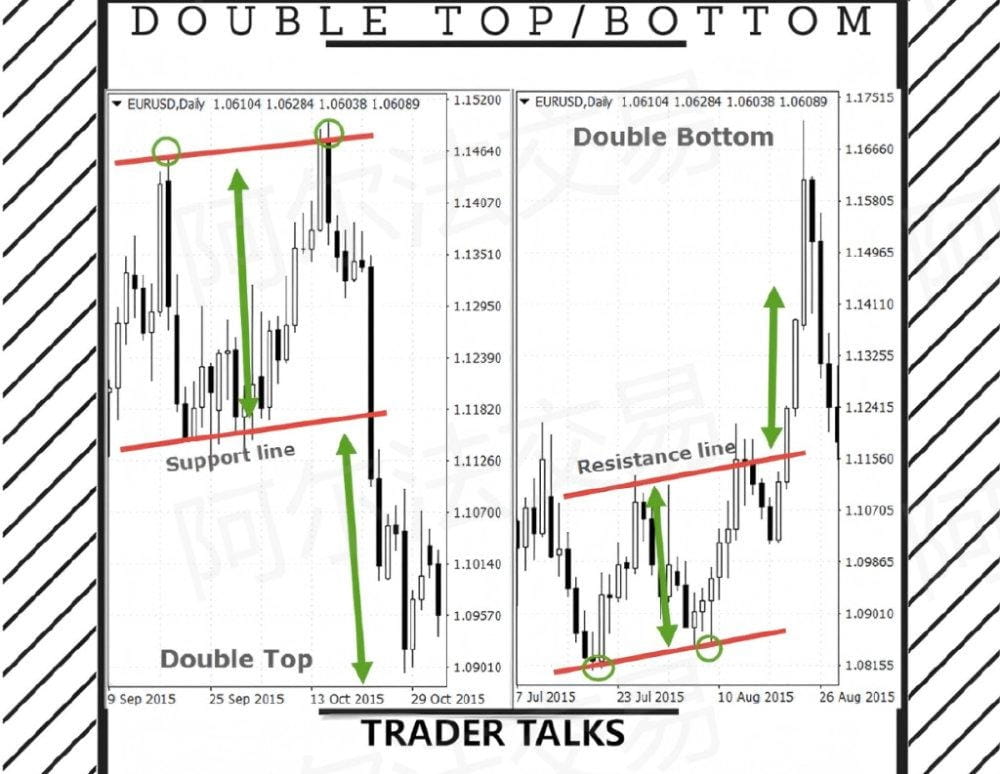
As another type of reversal pattern, double tops and double bottoms appear in uptrends and downtrends, respectively.
As the name suggests, a double top consists of two peaks of similar height (or slightly different). It indicates that the bulls failed to break through the previous high, and the trend may reverse.
Important Note: Trigger sell signal when the price drops below the pattern support line, with the target price being the vertical distance from the peak to the support line.
The double bottom pattern is the opposite, consisting of two troughs. It shows that the bears cannot continue to push the prices down. Buy when the price breaks through the resistance line, with the target price being the vertical distance from the trough to the resistance line.
Triple top and triple bottom
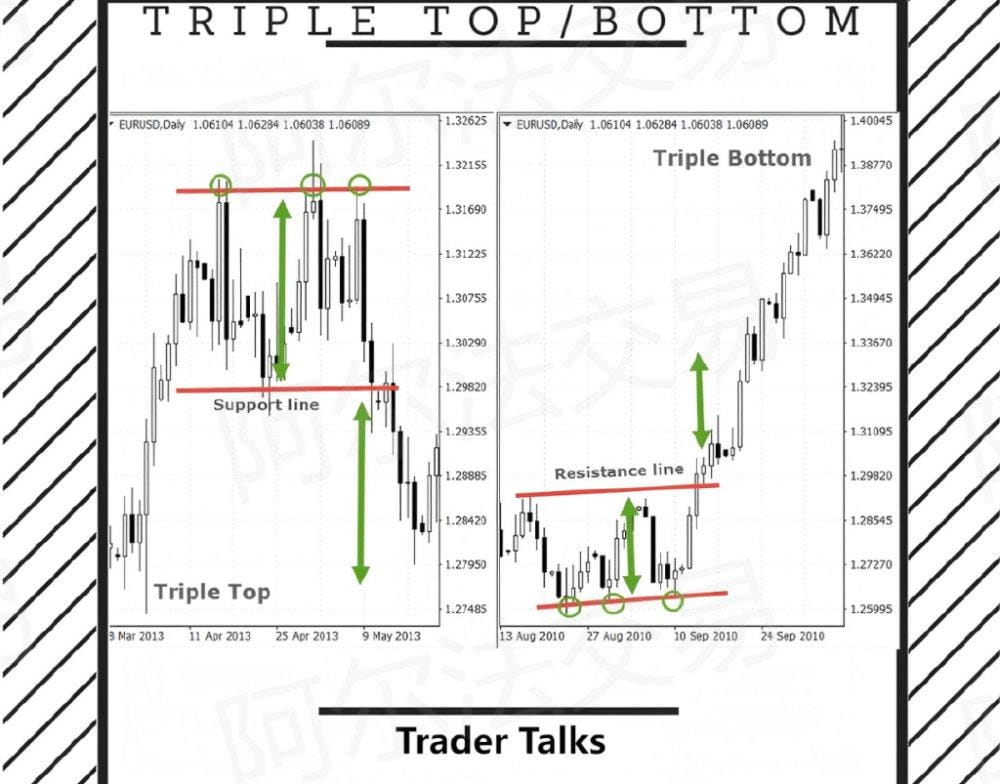
Triple top/bottom patterns are essentially extensions of double top/bottom patterns. Both are reversal patterns, with the difference being that triple tops/bottoms consist of three peaks and troughs, respectively.
Important Note: The trigger signal is also the breakout of support/resistance lines, with the target price calculation method being: for triple tops, the vertical distance from peak to support line; for triple bottoms, the vertical distance from trough to resistance line.
Rounding top
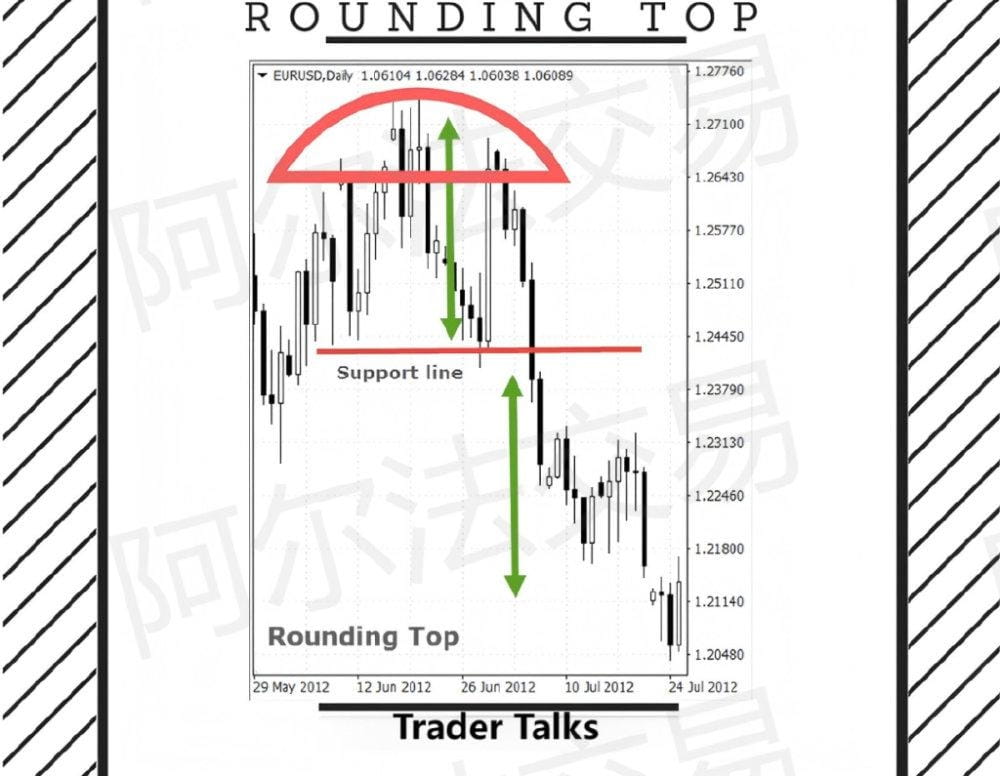
The rounding top (Rounding Top) pattern has a longer formation period than other patterns in this article. It reflects the gradual transition of market sentiment from a bull market to a bear market. As shown in the chart, the price gradually forms a 'dome' outline.
Important Note: Trigger short signal when the price drops below the support line, with the target price being the vertical distance from the top to the support line.
Rounding bottom
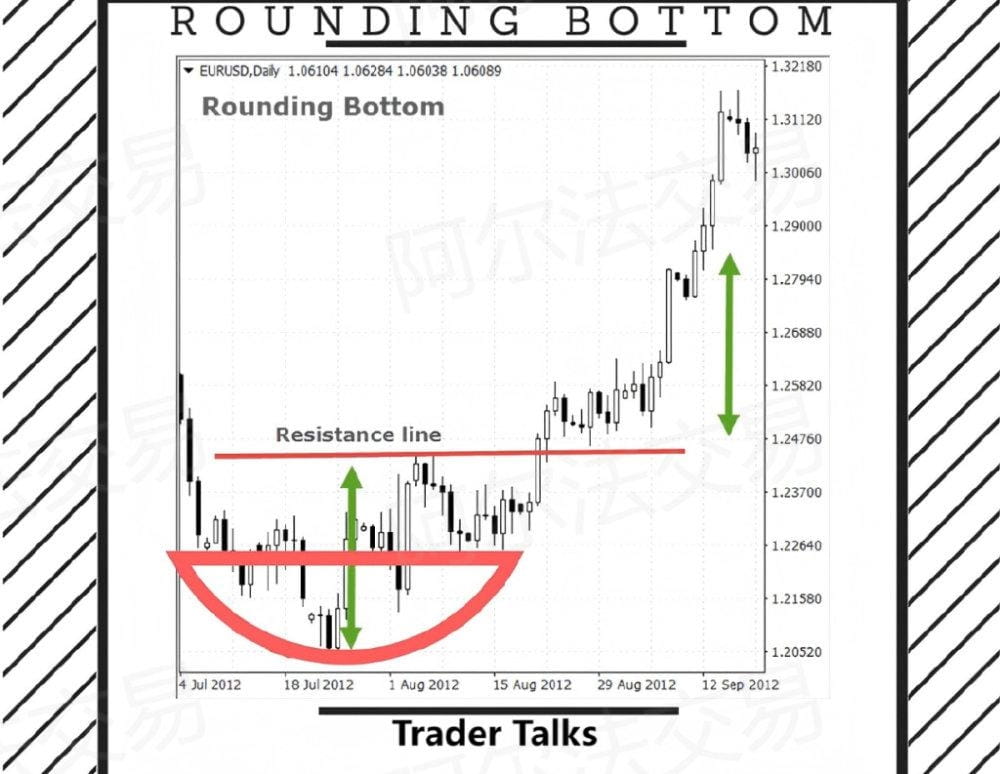
Rounding bottom (Rounding Bottom) is the mirror image of the rounding top. The price completes the gradual reversal of the downtrend through the 'rounded bottom' structure.
Important Note: Trading signals are the same as rounding tops - with the breakout of resistance lines as the trigger point, and the target price being the vertical amplitude from the bottom to the resistance line.
Continuation patterns (Part 2)
This article will reveal the most classic continuation patterns. Continuation patterns are equally important as reversal patterns and are more suitable for trend-following trading strategies. If reversal patterns are suitable for contrarian traders and swing traders, then continuation patterns provide excellent entry points for trend traders. The upcoming patterns will open a new perspective for your trading.
Rectangle pattern
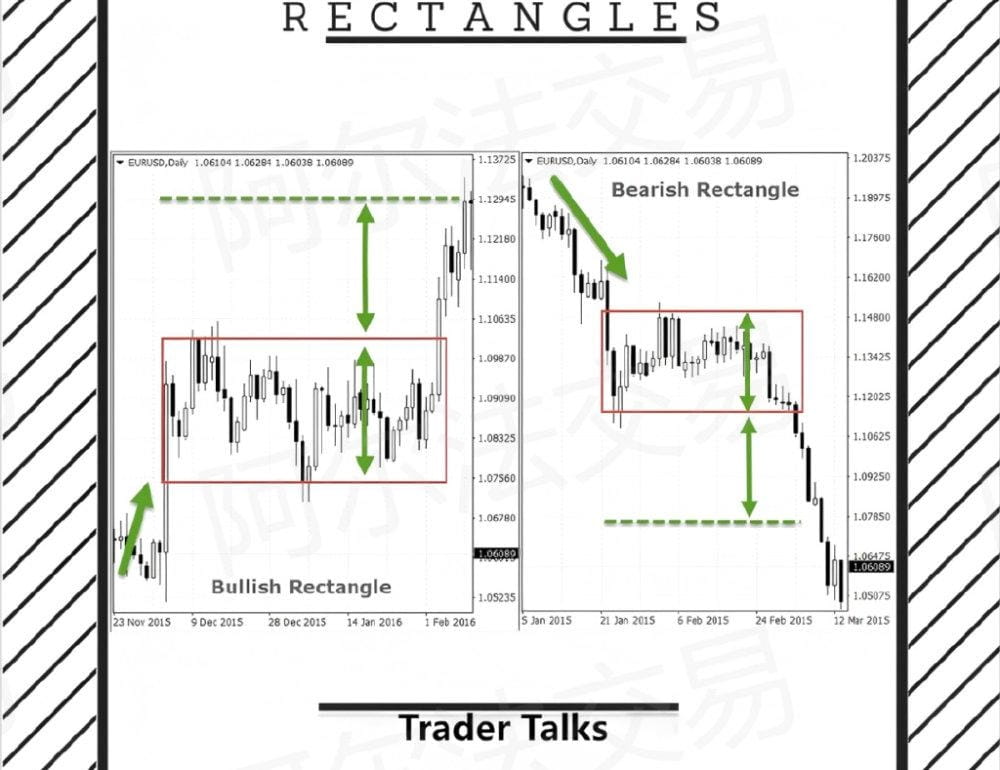
Rectangles belong to continuation patterns, confirming that the current trend will continue. Depending on the trend direction, they can be divided into bullish rectangles and bearish rectangles.
A bullish rectangle appears in an uptrend, forming when the price enters a sideways consolidation phase, and is likely to break through in the original trend direction.
Important Note: Trigger buy signal when the price breaks above the rectangle's upper boundary, with the target price being the height of the rectangle.
Bearish rectangles apply the opposite rule, forming in the consolidation phase of a downtrend, indicating that the price will ultimately break below the rectangle's lower boundary, with the target price amplitude also determined by the rectangle's height.
Wedge pattern
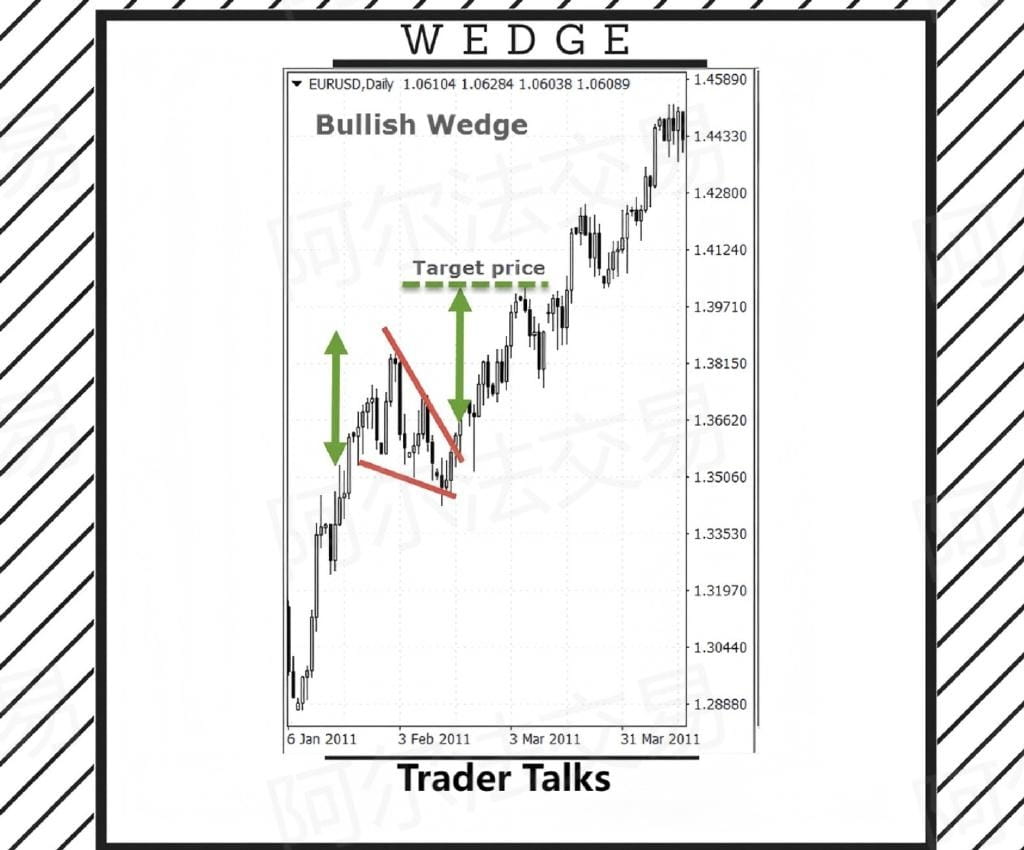
Wedges are another typical continuation pattern.
A bullish wedge appears in an uptrend, with the price moving within converging trend lines. This converging pattern indicates that the bears are trying to suppress the price but cannot overcome the strength of the bulls. Ultimately, the price breaks through the upper trend line, marking the continuation of the uptrend.
Important Note: The target amplitude takes the maximum vertical height of the wedge, projecting the same distance from the breakout point.
The principles of bearish and bullish wedges are the same, but they appear in a downtrend, with the overall slope tilting upward. The converging trend lines show that the bulls briefly interrupted the downtrend, and when the price breaks below the lower trend line, it indicates that the bears have regained control. The target amplitude is also projected based on the wedge's maximum height.
Flag pattern
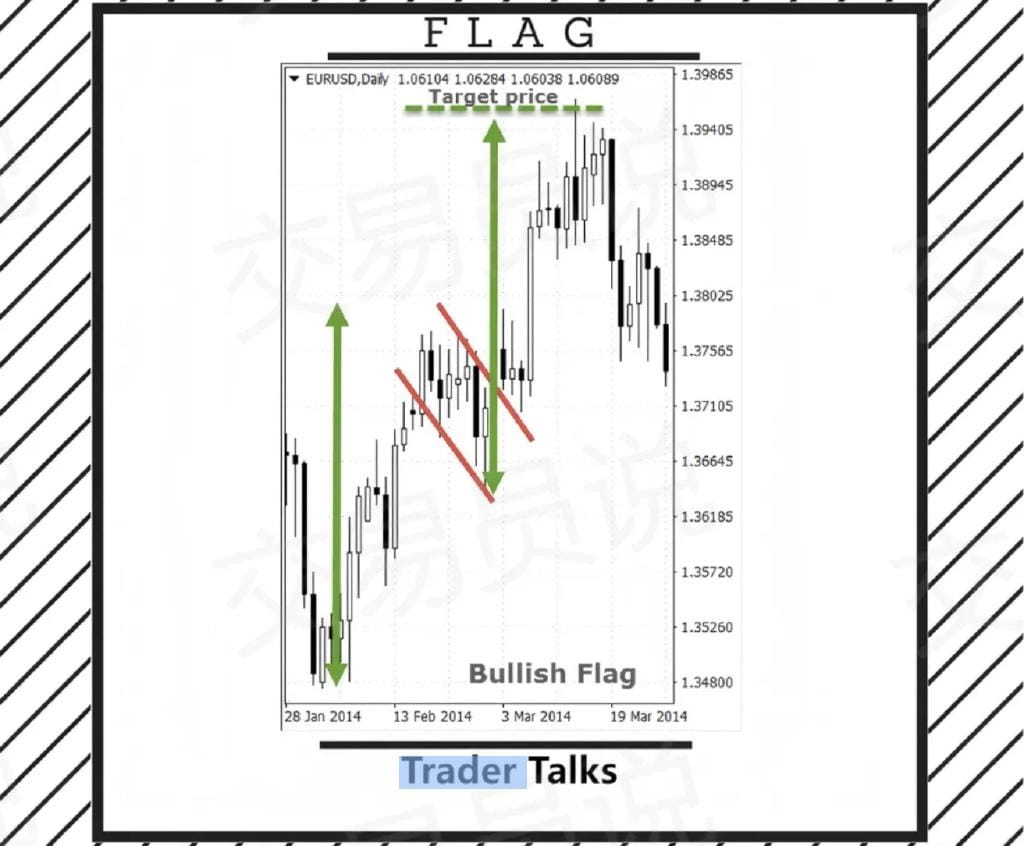
Flag patterns are similar to wedges but are composed of parallel (rather than converging) trend lines and include a signature flagpole structure, with a unique target measurement method that differs from other chart patterns.
Flag patterns are divided into bullish and bearish types; the above shows the bullish flag pattern.
A bullish flag forms in an uptrend, with parallel trend lines above and below the price movement, creating a downward slope.
Important Note: Breaking the above trend confirms that the upward trend is recovering.
Bearish flag pattern is basically the same as bullish flag pattern, except that the bearish flag pattern forms in a downtrend and has an upward trend.
Target amplitude calculation method: take the vertical height of the flagpole (green arrow), projecting from the end of the flag (lowest point for bullish flags/highest point for bearish flags).
Triangle pattern
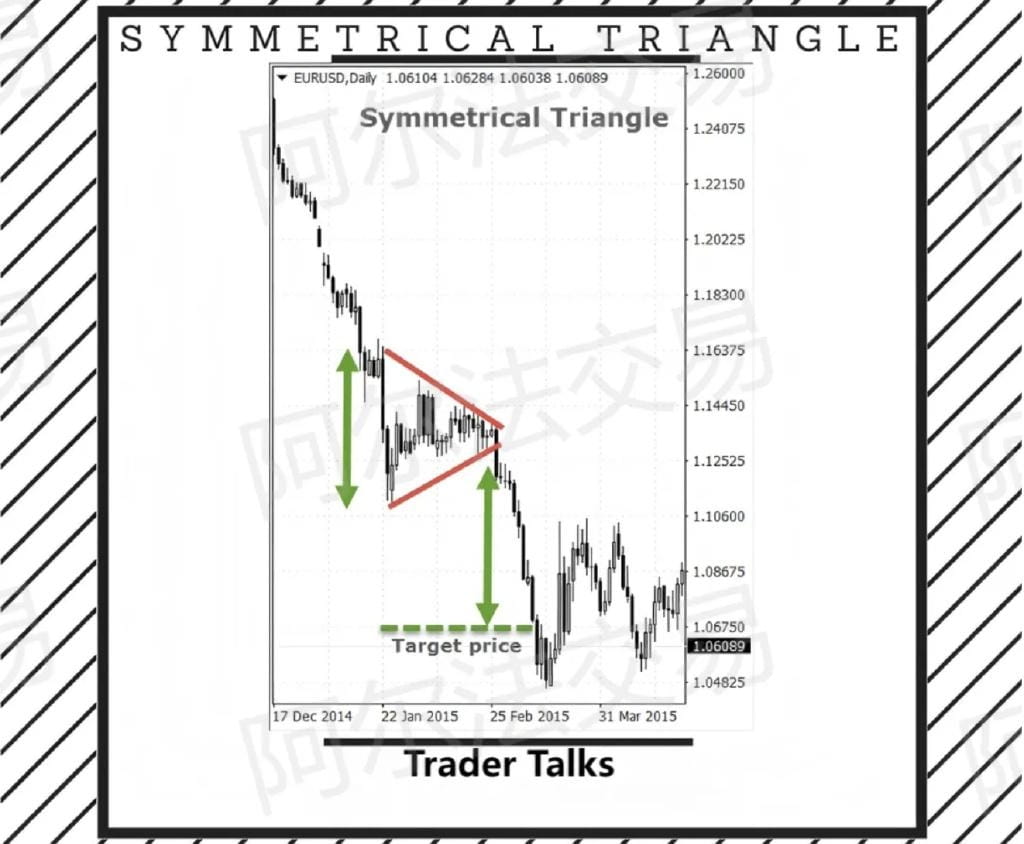
Triangles are divided into ascending triangles, descending triangles, and symmetrical triangles.
These three types of triangles look very similar, but the difference is that the ascending triangle has a flat upper trend line, while the descending triangle has a flat lower trend line.
The symmetrical triangle is the most common pattern, just like the wedge pattern, but the slope neither points upward nor downward, with no clear slope tendency.
Important Note: In a downtrend, breaking below the lower trend line indicates the continuation of the downtrend; while in an uptrend, breaking above the upper trend line confirms the original uptrend.
The target price equals the maximum height of the triangle, projected outward from the breakout point.
Cup and handle pattern
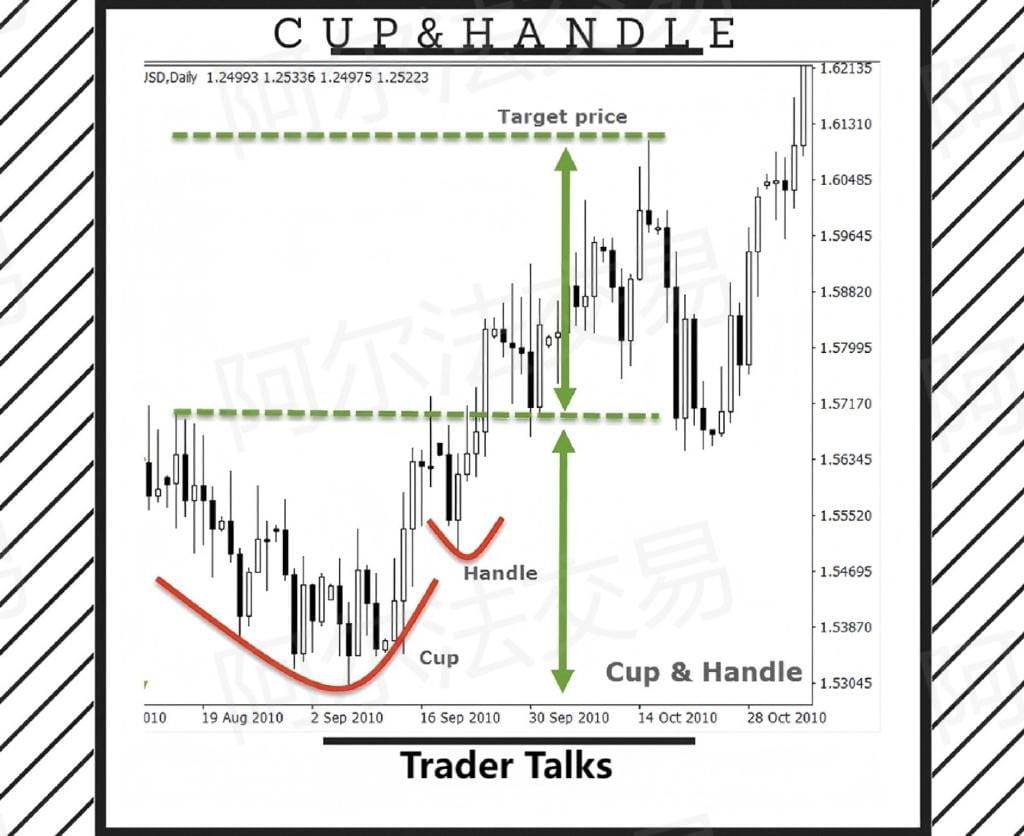
Cup and handle pattern (Cup and Handle) is a rounding top pattern characterized by an additional pullback (the 'handle' part) after the rounding top. It is a continuation pattern, indicating that in an uptrend, sellers are trying to push the price down, but market sentiment gradually shifts from sellers to buyers.
Moreover, the pullback (the formation of the handle) is the last attempt by sellers to control the market. When the price breaks through the resistance line (green dashed line), the method for calculating the target price is based on the height of the cup and handle pattern.
Inverse cup and handle pattern usually appears in a downtrend; its rules are the opposite of the regular cup and handle pattern.
Summary
The main purpose of this article is to show you another perspective on trading. As you can see, these chart patterns may help in judging the trend direction, but you should not rely solely on them.
In this article, we introduced ten major chart patterns that every trader should be aware of. We believe these are the most important, but if you feel I missed a key pattern, please share it in the comments.
Once again emphasize, as mentioned in our previous articles, that no trading method can be blindly copied. No single indicator is universal, and no trading system can maintain success under inappropriate operations. You need to find a method suitable for yourself and stick to it.


